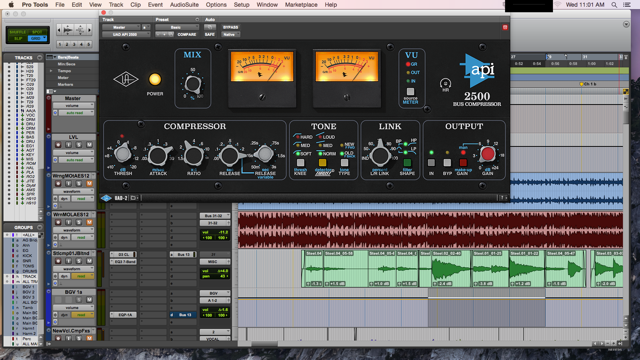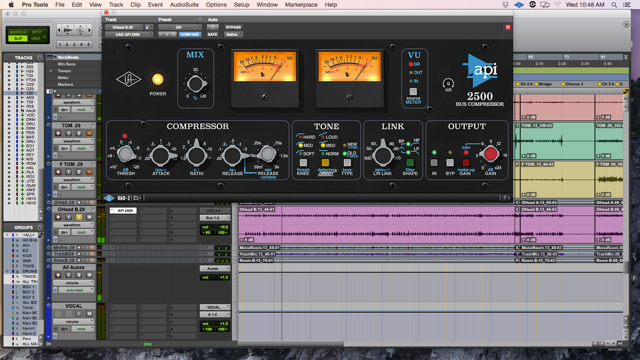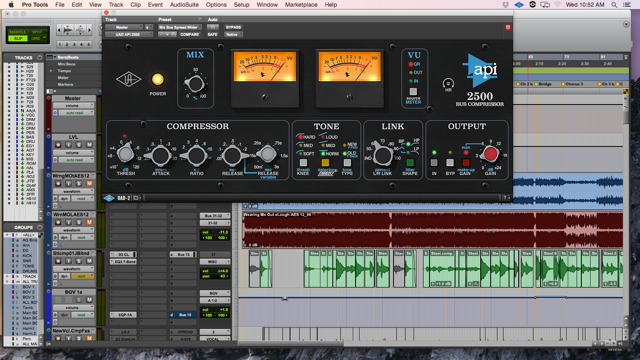3 Techniques: Universal Audio API 2500 Bus Compressor with Mixer Jeff Balding
Ready for a triple play of elite advice?
Our new “3 Techniques” series is a fast way for you to get fresh tips on recording, mixing, and mastering. For The Big Debut, were proud to present a trio of insights from an amazing mixer: Jeff Balding, the GRAMMY-nominated producer/mixer/recordist whose discography reads like a who’s who spanning multiple genres.
His plugin of focus is Universal Audio’s API 2500 Bus Compressor for UAD-2 and Apollo. It’s a faithful emulation of the classic compressor, which features an all-discrete signal path and meticulous modeling of API’s renowned custom transformers and 2510/2520 op amps.
Now dig into Jeff’s “3 Techniques” — they’re bound to inspire you every which way.
The Mixer: Jeff Balding
The Facility: Boom-Crash Studio, Franklin, TN
Select Credits: Don Henley, Maren Morris, Taylor Swift, Megadeth, Dan+Shay, Chris Janson, Little Big Town
Me as a Mixer: I’ve never been the mixer that does the factory template mix where you use your template and just plug everything in and blend it and you’re done. Being creative and experimenting is part of the fun of mixing. I like to take in the vision expressed by the producer and/or artist, and bring something to that.
One of the challenges as a mixer is to consistently bring something creative to the mix but at the same time not derail it. Bottom line it’s about making a song as “effective” and competitive as possible. I think another challenge as a mixer is to always be yourself in how you mix and don’t try to emulate what you think another mixer would do.
My Go-To Plugin: I’m attracted to the UAD API 2500 plugin because the API 2500 hardware has been my go-to bus compressor for several years. I like the clarity and punch it brings to a mix while retaining a very musical quality of the mix. Anytime I put the UAD API 2500 on the mix bus it always adds something to the quality of the mix.
3 TECHNIQUES:
Technique #1 – Setting Up the Stereo Bus: The stereo bus is one of the common places I use the UAD API 2500. It always brings a “glue” and presence to the mix in a musical way. A basic starting point on the stereo bus is:
Threshold: compressing 1 to 3 db
Ratio: 3:1
Attack: 30 ms or 10 ms
Release: variable (.15s)
Knee: “med”
Thrust: “med”
Type: “old”
Link: “70”
Filters: “HP” and “LP”
Gain: “engaged”
Technique #2 – Drum Overheads: At times I’ll use a Glyn Johns-style miking on drum overheads. The right compression setting on this miking style helps solidify the stereo image and brings the dynamic balance of the kit into focus. The API 2500 always works in this scenario.
Audio example 1: The Glyn Johns setup WITHOUT the API 2500 Bus Compressor:
Audio example 2: The Glyn Johns setup WITh the API 2500 Bus Compressor:
Technique #3 – Adding Depth & Width: I find that when you creatively use the link/filters and the right combination of ratio, attack and release on the UAD API 2500 you can get it to help spread the mix in both depth and width. And using the “mix control” on the plugin allows me to use a quicker attack time that I wouldn’t normally use, and blend the compression into the original signal to help get this effect.
Audio example 3: A stereo track WITHOUT widening/depth from the API 2500 Bus Compressor:
Audio example 4: A stereo track WITH widening/depth from the API 2500 Bus Compressor:
Final W.O.W. (Words Of Wisdom): When I find a new plugin, I go nuts and use it on everything for about three weeks to really discover what its strengths are.
What happens during that time frame? Week one: I get over the excitement of the plugin! Week two: I’m able to start evaluating the plugin without the emotional excitement of it being new. Then the third week: I start gravitating towards using it in the places it performs the strongest with consistency. By the end of that third week I really know the performance aspect of that plugin inside and out.
Please note: When you buy products through links on this page, we may earn an affiliate commission.











